#feeding south florida
Explore tagged Tumblr posts
Text
Feeding South Florida | Cuisine for a Cause
On October 3rd 2023, Feeding South Florida held a culinary experience, Cuisine for a Cause, featuring a gourmet four-course dinner crafted by celebrity chefs. Events on the Loose had the pleasure of being part of this event!
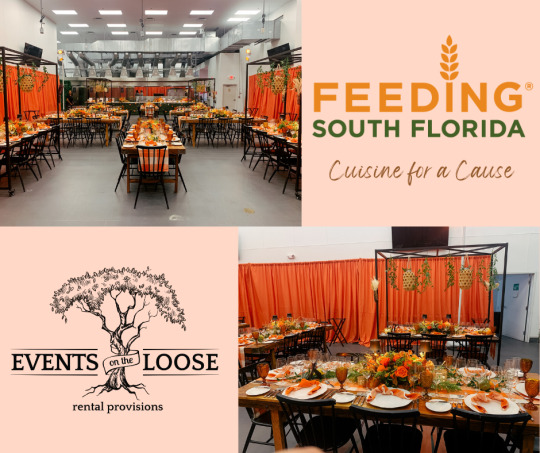
Local Celebrity Chefs included...
Chef Lindsay Autry of The Regional & Honeybelle
Chef Ralph Pagano of Naked Taco
Chef Bryce Statham of Spotos Fish & Oyster
Susan Taves of Feeding South Florida

Events on the Loose participated by including our rentals for a wonderful cause!


A special thank you to Richard Grille Events!
#Feeding South Florida#Events on the Loose#eventsontheloose#southflorida#rentalprovisions#eventdesign#rentals#events
1 note
·
View note
Note
ur clef design is very yummy yummymmmmm



clef says thanks
anywayzs..... thank you so much ???? here idk this took me too long and I added more stuff to him or smth. and finally drew his hawaiian shirt insteadof taking a png
als.o. I love your art. kitty clefdraki haunts me and your art style is so.... soft. yum. idunno thanks dude i had a heart attack when i saw this.... /pos
#simon draws#simon answers#dr alto clef#dr clef#alto clef#scp fanart#scp foundation#scp fandom#scp doctors#scp#francis wojciechoski#francis wojciechowski#agent ukulele#scp alto clef#scp dr clef#snfkjaeSGJBDSNGS?????#also ths took me TEN FUCKING DAYS#im so sorry but also im feeding yall#also also I'm in florida now#well driving there#in south carolina rn but will be in florida tmr
39 notes
·
View notes
Text
Wool-Carder Bees: these solitary bees harvest the soft, downy hairs that grow on certain plants, rolling them into bundles and then using the material to line their nests
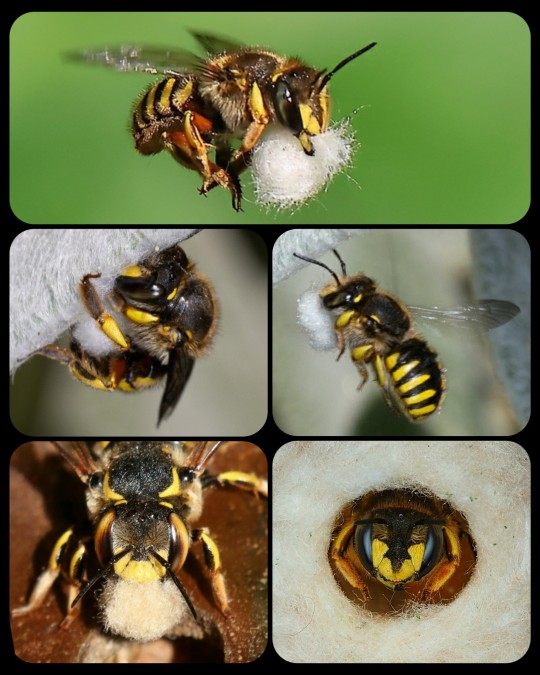
Wool-carder bees build their nests in existing cavities, usually finding a hole/crevice in a tree, a plant stem, a piece of rotting wood, or a man-made structure, and then lining the cavity with woolly plant fibers, which are used to form a series of brood cells.
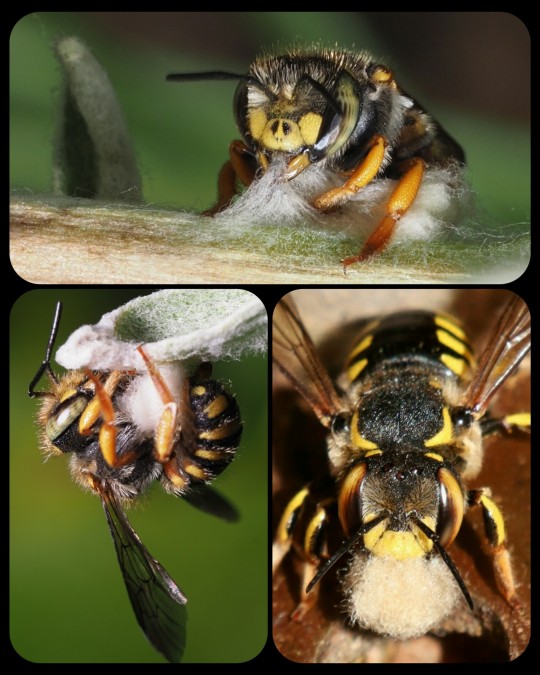
The fibers (known as trichomes) are collected from the leaves and stems of various plants, including lamb’s ear (Stachys byzantina), mulleins, globe thistle, rose campion, and other fuzzy plants.

From the University of Florida's Department of Entomology & Nematology:
The female uses her toothed mandibles to scrape trichomes off fuzzy plants and collects a ball of the material under her abdomen. She transports these soft plant fibers to her selected nest site and uses them to line a brood cell. Next, she collects and deposits a provision of pollen and nectar into the cell, enough pollen to feed a larva until it is ready to pupate. Lastly, she lays a single egg on top of the pollen and nectar supply before sealing the cell. ... She will repeat this process with adjoining cells until the cavity is full.
These are solitary bees, meaning that they do not form colonies or live together in hives. Each female builds her own nest, and the males do not have nests at all.
Female wool-carder bees will sometimes sting if their nest is threatened, but they are generally docile. The males are notoriously aggressive, however; they will often chase, head-butt, and/or wrestle any other insect that invades their territory, and they may defend their territory from intruders up to 70 times per hour. The males do not have stingers, but there are five tiny spikes located on the last segment of their abdomen, and they often use those spikes when fighting. They also have strong, sharp mandibles that can crush other bees.
There are many different types of wool-carder bee, but the most prolific is the European wool-carder (Anthidium manicatum), which is native to Europe, Asia, and North Africa, but has also become established as an invasive species throughout much of North America, most of South America, and New Zealand. It is the most widely distributed unmanaged bee in the world.

A few different species of wool-carder bee: the top row depicts the European wool-carder, A. manicatum (left) and the spotted wool-carder, Anthidium maculosum (right), while the bottom row depicts the reticulated small-woolcarder, Pseudoanthidium reticulatum, and Porter's wool-carder, Anthidium porterae
Sources & More Info:
University of Florida: The Woolcarder Bee
Oregon State University: European Woolcarder Bees
Bohart Museum of Entomology: Facts about the Wool Carder Bee (PDF)
Bumblebee Conservation Trust: A. manicatum
World's Best Gardening Blog: European Wool Carder Bees - Likeable Bullies
Biological Invasions: Global Invasion by Anthidium manicatum
#entomology#hymenoptera#apiology#melittology#bees#woolcarder bees#nature#insects#arthropods#science#solitary bees#european woolcarder#anthidium#animal facts#cool bugs#cute animals
3K notes
·
View notes
Text
I wish I had thought of posting this sooner: if you feel like you have to stay because of your pets, those lists do say which shelters are pet friendly. My best friend did run into the problem of a shelter being willing to accept her dog but not her bird (she has found somewhere to stay now). Here are some general tips on how to evacuate with pets:
If you will need to go to a pet friendly shelter during an evacuation, make sure you have the following items ready to go for your pet: a leash and collar, a crate [or carrier for cats or smaller pets], a two-week supply of food and water, your pets’ vaccination records and a current rabies vaccination tag, medications, and written instructions for feeding and administering medication. If your favorite four-legged friend is feline, be sure you bring kitty-litter and an appropriate container, too.
You may not have all of these things (like records) at hand, but as a general rule, try to gather anything your pet uses on a daily basis. I know some of this seems obvious, but sometimes people can just shut down because they get overwhelmed and can’t think through what to do, so they just stay. I wish I’d thought to look this up and post it days ago, but maybe this can help people make some last minute decisions.
If you can’t find a shelter that will take certain animals (I don’t know the restrictions per se), this article about FEMA efforts suggest that even getting a few miles out of the hurricane’s path can be safer. I don’t know the Florida terrain well enough to tell you how to get to higher ground, but even a parking lot miles inland north or south may be safer than your home near the coast. But be careful about getting caught in your car in the storm surge flooding, I don’t want to lead you astray—listen to experts, not me; these are last-ditch ideas we had to spitball yesterday (me on the phone in a different state) when things looked bad.
Anybody who has more info or better ideas for evacuation with pets or last-minute safety, please chime in.
439 notes
·
View notes
Note
may i request some black and red snakes?
Let me see what I have for you...

Black-banded Trinket Snake aka Red Bamboo Snake (Oreocryptophis porphyraceus), juvenile, family Colubridae, Thailand
photograph by Thai National Parks

Oregon Red-spotted Garter Snake (Thamnophis sirtalis concinnus), family Colubridae, Oregon, USA
photograph by Dan Loida Buama-Hyman

Eastern Mud Snake (Farancia a. abacura), family Colubridae, MIssouri, USA
This gorgeous nocturnal aquatic snake feeds on aquatic salamanders, like sirens and amphiumas, which it pins down with its sharp pointed tail.
photograph by Peter Paplanus

Rainbow Snake (Farancia erytrogramma), family Colubridae, Florida, USA
Fossorial, semi-aquatic, known for feeding on eels (but feed on other small creatures).
photograph by Kevin Enge/FWC

American Pipe Snake aka False Coral Snake (Anilius scytale), family Aniliidae, Brazil
This family is monotypic, containing only this species.
This species is considered to be quite primitive in its anatomy.
photograph by Eduardo Santos

Banded or Tri-colored Hognose Snake (Xenodon pulcher), family Colubridae, South America
Coral snake mimic.
Previously known as Lystrophis pulcher.
photographs by jakescott
247 notes
·
View notes
Text
The loss of life and impact on the communities in Helene’s path is unfathomable — and both the immediate and long-term needs are vast.
If you’re reading this, it’s likely because you want to help and care about making a difference for those who’ve been impacted by Hurricane Helene.
You’re in the right place. When we see tragedy like this happen in the news, it’s important to not tune it out. Instead, pay attention and truly feel the heartbreak of it — then, look for and be inspired by the people stepping in to help, and use that energy to make a difference ourselves.
Looking for the helpers
Instead of turning away from tragic events like the devastation from Hurricane Helene — we look closer for people stepping in using what they have, where they are, to make a difference for others.
Inspired by Mister Rogers’ famous quote, we call them the “helpers,” — and they’re usually found wherever there’s bad news in the world. Hurricane Helene is no different. Here are some people, businesses, and organizations helping right now:
Chef José Andrés and World Central Kitchen teams are serving thousands of meals to communities in need — from Mexico, and the Big Bend of Florida, and into Appalachia.
Volunteer pilots with the Port City Aviators Flying Club are flying supplies to storm victims in western North Carolina.
The national Disaster Distress Helpline is providing free multilingual crisis counseling to those in need.
Southern Smoke Foundation, an organization that supports food & beverage workers in crisis, is providing financial support for groceries, medical bills, lost wages, and more.
Volunteers with veteran-led disaster response organization Team Rubicon are on the ground in Greenwood, South Carolina clearing roads of trees and debris.
A local library branch in Asheville, North Carolina served as a hub for community members in need of internet service.
Workers at Waffle House were “unlikely heroes” providing food to people in need.
A local Fox News correspondent stopped his live broadcast to help rescue a woman trapped in her car in rising floodwaters.
Emergency response teams rescued more than 50 staff, patients, and caregivers from the roof of a hospital in Erwin, Tennessee.
The SPCA of Brevard rescued 20 animals from Hurricane Helene’s path — and it’s now helping them get adopted.
How to make a difference
After we’ve allowed ourselves to feel the weight of the pain and heartbreak associated with bad news, and look for hope and helpers in the midst of it — we always have the opportunity to join in and make a difference, too.
Here are some ways to help — whether you’re local or far away:
Donate to national organizations
Here are just a few large-scale organizations that have helpers on the ground in the region.
American Red Cross
World Central Kitchen
Feeding America
United Way
Salvation Army
CARE
Donate to local organizations
Local organizations, recovery funds, and mutual aid groups have been deployed across the states impacted by Helene. Find donation links and updates below:
All States:
GoFundMe Hub for Hurricane Helene Relief
Mutual Aid Disaster Relief
Southeast Climate & Energy Network
Convoy of Hope
Appalachia Funders Network
Americares
Organizing Resilience
The National Voluntary Organizations Active in Disaster
Tennessee:
East Tennessee Foundation
First Aid Collective Knoxville
RISE Erwin
Second Harvest Food Bank of East Tennessee
North Carolina:
North Carolina Community Foundation
Hearts With Hands
Manna Foodbank
BeLoved Asheville
Foothills Food Hub
Haywood Christian Ministry
Samaritan’s Purse
Forsyth Humane Society
Hope Mill
Volunteer locally
Organizations in the affected area are seeking volunteers to help distribute resources and support crucial aid efforts. While many of us are not local to the region, those who are nearby are encouraged to join in a myriad of volunteer opportunities.
(Note: If you aren't in the area, the best way you can help is by supporting local efforts with a donation. Keeping roads clear for rescue crews and local relief agents is vital in maintaining safety in these already devastated regions).
For local volunteers, check out:
World Central Kitchen
Operation BBQ Relief
Marco Patriots
Operation Airdrop
Baptists on Mission
Contact your elected officials and ask them to take climate action
Climate scientists agree, the intensity and extent of the devastation brought by Hurricane Helene was made worse by climate change.
While we can’t go back in time and burn less fossil fuels — we can make a difference now to secure a safer future and prevent future climate disasters.
In addition to talking about how this disaster is connected to climate change in our own conversations and holding media outlets accountable for how they talk about climate change — this is a great time to tell your elected officials that you want them to take meaningful climate action.
We’re making incredible progress in the U.S. and globally in reducing emissions, but we need to work even faster — and incorporate climate mitigation efforts into our plans — to limit the most severe impacts of global warming.
#united states#hurricane#hurricane helene#carolina hurricanes#hurricane season#natural disaster#disaster aid#appalachia#psa#volunteer#today is posting about hurricane helene day for me apparently
305 notes
·
View notes
Text
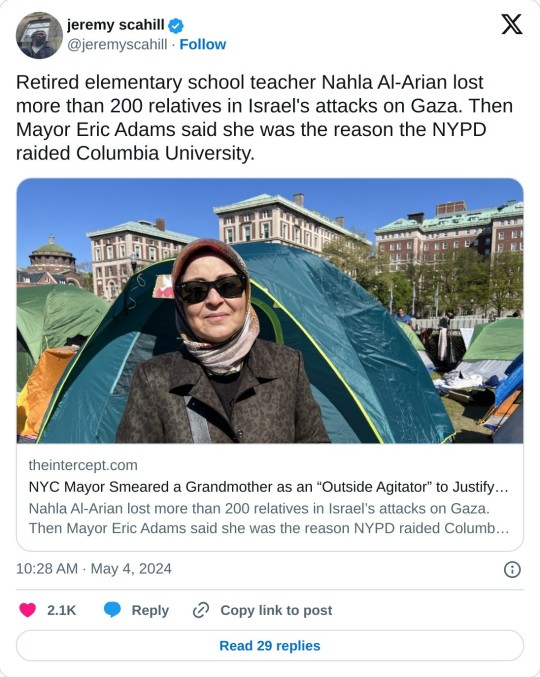
NAHLA AL-ARIAN HAS been living a nightmare for the past seven months, watching from afar as Israel carries out its scorched-earth war against her ancestral homeland in the Gaza Strip. Like many Palestinian Americans, the 63-year-old retired fourth-grade teacher from Tampa Bay, Florida, has endured seven months of a steady trickle of WhatsApp messages about the deaths of her relatives. “You see, my father’s family is originally from Gaza, so they are a big family. And they are not only in Gaza City, but also in Deir al Balah and Khan Younis, other parts,” Al-Arian told me. Recently, the trickle of horrors became a flood: “It started with like 27, and then we lost count until I received this message from my relative who said at least 200 had died.” The catastrophe was the backdrop for Al-Arian’s visit last week to Columbia University in New York City. Al-Arian has five children, four of whom are journalists or filmmakers. On April 25, two of her daughters, Laila and Lama, both award-winning TV journalists, visited the encampment established by Columbia students to oppose the war in Gaza. Laila, an executive producer at Al Jazeera English with Emmys and a George Polk Award to her name, is a graduate of Columbia’s journalism school. Lama was the recipient of the prestigious 2021 Alfred I. duPont–Columbia Award for her reporting for Vice News on the 2020 explosion at the port of Beirut. The two sisters traveled to Columbia as journalists to see the campus, and Nahla joined them. “Of course, I tagged along. You know, why would I sit at the hotel by myself? And I wanted to really see those kids. I felt so down,” she said. “I was crying every day for Gaza, for the children being killed, for the women, the destruction of my father’s city, so I wanted to feel better, you know, to see those kids. I heard a lot about them, how smart they are, how organized, you know? So I said, let’s go along with you. So I went.” Nahla Al-Arian was on the campus for less than an hour. She sat and listened to part of a teach-in, and shared some hummus with her daughters and some students. Then she left, feeling a glimmer of hope that people — at least these students — actually cared about the suffering and deaths being inflicted on her family in Gaza. “I didn’t teach them anything. They are the ones who taught me. They are the ones who gave me hope,” she recalled. “I felt much better when I went there because I felt those kids are really very well informed, very well educated. They are the conscience of America. They care about the Palestinian people who they never saw or got to meet.” Her husband posted a picture of Nahla, sitting on the lawn at the tent city erected by the student protesters, on his Twitter feed. “My wife Nahla in solidarity with the brave and very determined Columbia University students,” he wrote. Nahla left New York, inspired by her visit to Columbia, and returned to Virginia to spend time with her grandchildren. A few days later, that one tweet by her husband would thrust Nahla Al-Arian into the center of a spurious narrative promoted by the mayor of New York City and major media outlets. She became the exemplar of the dangerous “outside agitator” who was training the students at Columbia. It was Nahla’s presence, according to Mayor Eric Adams, that was the “tipping point” in his decision to authorize the military-style raids on the campus.
On February 20, 2003, Nahla’s husband, Sami Al-Arian, a professor at the University of South Florida, was arrested and indicted on 53 counts of supporting the armed resistance group Palestinian Islamic Jihad. The PIJ had been designated by the U.S. government as a terrorist organization, and the charges against Al-Arian could have put him in prison for multiple life sentences, plus 225 years. It was a centerpiece case of the George W. Bush administration’s domestic “war on terror.” When John Ashcroft, Bush’s notorious attorney general, announced the indictment, he described the Florida-based scholar as “the North American leader of the Palestinian Islamic Jihad, Sami Al-Arian.” Among the charges against him was conspiracy to kill or maim persons abroad, specifically in Israel, yet the prosecutors openly admitted Al-Arian had no connection to any violence. He was a well-known and deeply respected figure in the Tampa community, where he and Nahla raised their family. He was also, like many fellow Palestinians, a tenacious critic of U.S. support for Israel and of the burgeoning “global war on terror.” His arrest came just days before the U.S. invaded Iraq, a war Al-Arian was publicly opposed to. The Al-Arian case was, at its core, a political attack waged by Bush’s Justice Department as part of a wider assault on the rights of Muslims in the U.S. The government launched a campaign, echoed in media outlets, to portray Al-Arian as a terror leader at a time when the Bush administration was ratcheting up its so-called global war on terror abroad, and when Muslims in the U.S. were being subjected to harassment, surveillance, and abuse. The legal case against Al-Arian was flimsy, and prosecutors largely sought to portray his protected First Amendment speech and charitable activities as terrorism. The trial against Al-Arian, a legal permanent resident in the U.S., did not go well for federal prosecutors. In December 2005, following a six-month trial, a jury acquitted him on eight of the most serious counts and deadlocked 10-2 in favor of acquittal on the other nine. The judge made clear he was not pleased with this outcome, and the prosecutors were intent on relitigating the case. Al-Arian had spent two years in jail already without any conviction and was staring down the prospect of years more. In the face of this reality and the toll the trial against him had taken on his family, Al-Arian agreed to take a plea deal. In 2006, he pleaded guilty to one count of providing nonviolent support to people the government alleged were affiliated with the PIJ. As part of the deal, Al-Arian would serve a short sentence and, with his residency revoked, get an expedited deportation. At no point during the government’s trial against Al-Arian did the prosecution provide evidence he was connected to any acts of violence. For the next eight years following his release from prison in 2008, Al-Arian was kept under house arrest and effectively subjected to prosecutorial harassment as the government sought to place him in what his lawyers characterized as a judicial trap by compelling him to testify in a separate case. His defense lawyers alleged the federal prosecutor in the case, who had a penchant for pursuing high-profile, political cases, held an anti-Palestinian bias. Amnesty International raised concerns that Al-Arian had been abused in prison and he faced the prospect of yet another lengthy, costly court battle. The saga would stretch on for several more years before prosecutors ended the case and Al-Arian was deported from the United States.
“This case remains one of the most troubling chapters in this nation’s crackdown after 9-11,” Al-Arian’s lawyer, Jonathan Turley, wrote in 2014 when the case was officially dropped. “Despite the jury verdict and the agreement reached to allow Dr. Al-Arian to leave the country, the Justice Department continued to fight for his incarceration and for a trial in this case. It will remain one of the most disturbing cases of my career in terms of the actions taken by our government.” That federal prosecutors approved Al-Arian’s plea deal gave a clear indication that the U.S. government knew Al-Arian was not an actual terrorist, terrorist facilitator, or any kind of threat; the Bush administration, after all, was not in the habit of letting suspected terrorists walk. Al-Arian and his family have always maintained his innocence and say that he was being targeted for his political beliefs and activism on behalf of Palestinians. He resisted the deal, Nahla Al-Arian said. “He didn’t even want to accept it. He wanted to move on with another trial,” Nahla said. “But because of our pressure on him, let’s just get done with it [because] in the end, we’re going leave anyway. So that’s why.” Sami and Nahla Al-Arian now live in Turkey. Sami is not allowed to visit his children and grandchildren stateside, but Nahla visits often.
#yemen#jerusalem#tel aviv#current events#palestine#free palestine#gaza#free gaza#news on gaza#palestine news#news update#war news#war on gaza#columbia university#students for justice in palestine#gaza solidarity encampment#police brutality#islamophobia#war on terror#gaza genocide#genocide
464 notes
·
View notes
Text
HURRICANE HELENE AND MILTON RELIEF
As most of you know, I was born and raised in South Florida, and until recently, lived in central Florida. I want to provide some donation resources in the aftermath of Hurricane Helene and Hurricane Milton. There are a number of ways to help both from afar and locally. If you can't help - that is okay. This is not an economy made for being able to help others, so feel free to spread resources/awareness and let me know of any additional resources I can add here.
Note: This is not an exhaustive list of ways to help those suffering from the effects of Hurricane Helene and Hurricane Milton, and many of these are Florida-based because it's what I'm familiar with. If you know of resources specific to the Carolinas and areas in Appalachia that I can add, please let me know!
AMERICAN RED CROSS
Monetary Donation | Find A Local Blood Drive
VOLUNTEER FLORIDA
Donate to the Florida Disaster Fund
UNITED WAY
Donate for Hurricane Relief
FEEDING TAMPA BAY
Donate to help feed victims of hurricanes
WE ARE ST. PETE
Donate for Hurricane Relief
AMERICARES
Donate for Hurricane Helene Relief
GREATER GOOD CHARITIES
Donate for Hurricane Helen and Hurricane Milton Relief
HUMANE SOCIETIES
Florida Humane Society | Humane Society Tampa Bay | Humane Society Sarasota | Humane Society Pinellas | Humane Society Polk County |
SALVATION ARMY
Donate for Hurricane Helene and Hurricane Milton Relief
FEMA
Email [email protected] for in-kind donations
MUTUAL AID DISASTER RELIEF
Donate to Hurricane Recovery
BELOVED ASHEVILLE
Donate for Hurricane Helene Relief in Asheville
COLLECTION SITES
A ton of different places in the south will have donation drives/collection sites to drop off donation materials. You'll have to do some research wherever you are locally, but if you live near a sports team, event stadium, or a YMCA in the south, they will most likely host relief drives in their parking lots!
#hurricane relief#again this list is no where near exhaustive but they're the core places i know you can reliably donate#and obvious hurricane milton has barely even started right now but i know its not good#hurricane milton relief#hurricane helene relief
74 notes
·
View notes
Text
Fish of the Day
Today's fish of the day is the bonnethead shark!

The bonnethead shark, also called bonnet shark, or shovelhead, scientific name Sphyrna tiburo, is known for its unique head shape. It is often thought that the bonnethead shark is a young hammerhead shark, and despite belonging to the same family, Sphyrnidae, they are not the same species. Unlike the hammerheads worldwide range, the bonnethead shark's natural range only stretches from Southern Canada down to The coast of Brazil and Peru, with populations on both coasts of the Americas. It lives primarily in estuaries or bays, living around vegetation, sandy bottomed areas, or reefs. These are a migratory species: during the summer they move inshore and further North, but during Winter they move back south. Eastern populations concentrate around the Carolinas in Summer, and the Florida coast or Caribbean sea during the other months, but there are no concentrated points known for Pacific populations.

Bonnethead sharks, similar to other sharks of their size, eat primarily crustaceans. Crabs, shrimp, mollusks, and small fish. Similar to hammerhead sharks, they have many electromagnetic sensors on the underside of the head, this is the reason for the spade shape as the spacing of the sensors allows them to better find prey below them. They hunt along the sea bed, moving the head similar to how one moves a metal detector, looking for electromagnetic irregularities produced by living beings. After detection, the shark turns sharply and bites into the sediment, then grinding prey and swallowing. When unable to find prey, or in larger groups they also have been found eating seagrass. Other than for detection of prey, this head can also be used for better vision: as the eyes are faced to the sides this gives them a much wider field of view, allowing them to see if any predators are around, something that gives them a higher chance of surviving past childhood.

The reproduction of the bonnethead shark is viviparous, meaning that the baby is formed inside the mother and born alive. breeding is thought to take place around spring and autumn in the Atlantic populations, but may take place year round without a proper season for it. However, these fish will breed only after they've reached 31 inches in females, and 24 inches in males at around their second year of life. Then, after breeding, gestation takes only 5 months before they have anywhere between 4-12 pups, who are already 12 inches in length. These pups are then abandoned, primarily to keep the parents from feeding on their own offspring, and will live in and around seagrass beds they were born in. This is where they can hide from predators for the first few years. The largest bonnethead shark reported was 4 feet in length, but most are only 2.5-3 feet long. Male and female bonnetheads can be told apart by the sexual dimorphic morophology of the head shape. In females, the head is rounded, but males have a bulge shape around the midline of the head, referred to as a cephalofoil.

Their behavior is unlike many sharks, as bonnetheads are known to exist in groups. Living in smaller numbers of 5-15 in a pod, although there have been schools of thousands reported to be traveling with one another. These groups are not territorial, but they have a hierarchy within them. Strangest of all, these sharks appear to communicate with one another using cerebrospinal fluid as a chemical communicator between individual sharks, letting the others know where they are at any given time.

That's the bonnethead shark, everybody! Have a wonderful day.
#fish#fish of the day#fishblr#fishposting#aquatic biology#marine biology#freshwater#freshwater fish#animal facts#animal#animals#fishes#informative#education#aquatic#aquatic life#nature#river#ocean#shark#sharks#bonnethead#bonnethead shark#bonnet shark#shovel shark#shovelhead shark#hammerhead shark
127 notes
·
View notes
Text
What if Tucson’s million new trees — and the rest of the country’s — didn’t just keep sidewalks cool? What if they helped feed people, too? That’s what Brandon Merchant hopes will happen on the shadeless south side of Tucson, a city where about one-fifth of the population lives more than a mile from a grocery store. He’s working on a project to plant velvet mesquite trees that thrive in the dry Sonoran Desert and have been used for centuries as a food source. The mesquite trees’ seed pods can be ground into a sweet, protein-rich flour used to make bread, cookies, and pancakes. Merchant, who works at the Community Food Bank of Southern Arizona, sees cultivating mesquite around the city and surrounding areas as an opportunity to ease both heat and hunger. The outcome could be a network of “food forests,” community spaces where volunteers tend fruit trees and other edible plants for neighbors to forage. “Thinking about the root causes of hunger and the root causes of health issues, there are all these things that tie together: lack of green spaces, lack of biodiversity,” Merchant said. (The food bank received half a million dollars from the Biden administration through the Inflation Reduction Act.) Merchant’s initiative fits into a national trend of combining forestry — and Forest Service funding — with efforts to feed people. Volunteers, school teachers, and urban farmers in cities across the country are planting fruit and nut trees, berry bushes, and other edible plants in public spaces to create shade, provide access to green space, and supply neighbors with free and healthy food. These food forests, forest gardens, and edible parks have sprouted up at churches, schools, empty lots, and street corners in numerous cities, including Boston, Philadelphia, Atlanta, Seattle, and Miami. “It’s definitely growing in popularity,” said Cara Rockwell, who researches agroforestry and sustainable food systems at Florida International University. “Food security is one of the huge benefits.” There are also numerous environmental benefits: Trees improve air quality, suck carbon from the atmosphere, and create habitat for wildlife, said Mikaela Schmitt-Harsh, an urban forestry expert at James Madison University in Virginia. “I think food forests are gaining popularity alongside other urban green space efforts, community gardens, green rooftops,” she added. “All of those efforts, I think, are moving us in a positive direction.”
210 notes
·
View notes
Text

It takes one to know one
Article: The FBI isn't just hunting psychopaths, they're head-hunting them too, offering competitive pay and benefits in the hopes of using one demented mind to catch another. Sure, we're familiar with the stereotype of the FBI profiler, swaggering onto a crime scene, fitting the pieces together like a master puzzler with his 1000-piece jigsaw. In reality, these profilers should be likened to harridans reading a cup of spent tealeaves- passing off their active imagination as incisive fact.
Fact Check: Drunk Iowa Driver's Alcohol Level Was Nearly Eight Times Legal Limit Article: Florida Woman Busted For DUI Tells Cop, "This Is What I Get For being a bridesmaid" Press Pass: South Carolina Man Attacked Grandmother Over Bizarre Chick Salad Mix-Up Press Pass: Open Gown, A Universal Hospital Indignity, Leads To Indiana Man's [unreadable]

Another Shrike In the Nest?
by Frederica Lounds
As reported before by Tattlecrime, the FBI maintains jurisdiction in the case of Garret Jacob Hobbs, the Minnesota Shrike. But as days turn to weeks, desperation has begun to take hold amongst the investigators. An embarrassing truth is beginning to emerge: There are no new leads on the whereabouts of the Shrike's seven missing victims. As families await any word at all about their lost daughters, the case looks as though it has stalled. Tip lines are open, but they have so far yielded little to nothing. Where lie these poor women who deserve a proper funeral? When approached for comment on the investigation, things with Graham took a surprising and dark turn. Upset at the probity of the questions at hand, Graham threatened, "It's not very smart to piss of a guy who thinks about killing people for a living." A statement like this calls into question the very mind and method of Will Graham and his FBI apologists. This is a man who skirted normal FBI... Read More

It Takes One To Catch One?
PHOTO EXLUSIVE - INSIDE THE LEEDS HOME
Exclusive photos of house where the Jacobi family was slaughtered.
The Jacobi home nestled in a sleepy suburb of Chicago that was startled awake by the shocking murder that has changed the area forever. Residents that have lived in the area for almost twenty years have said that they will now consider moving. See the disturbing exclusive photos inside.
Insane Fiend Consulted in Mass Murders by Agent He Tried To Kill
by Freddie Lounds
FEDERAL MANHUNTERS, stymied in their search for the Tooth Fairy, have turned to the most savage killer in captivity for help. Hannibal the Cannibal has gotten a call from a very special visitor- none other than Will Graham himself. I saw it with my own eyes, Graham coming form the main entrance to the Baltimore State Hospital for the Criminally Insane on a recent afternoon. This mysterious visit had this reporter curious to its nature. What could Graham, who was almost a victim of Lecter himself, have to discuss with the Mad Doctor? A bit more digging lead me to face to face discussion with Will Graham. Needless to say he was evasive. But I was able to suss out that Graham has begun working for the FBI again on the Tooth Fairy investigation. And he was in fact visiting Lecter to help him get information on the Tooth Fairy murders. Is this really where to FBI has sunk? Hiring a man with questionable stability to get information form a clinically insane psychotic? If this is where the FBI has been able to take this investigation, this reporter is worried. Worried for the family left behind by the Leeds and Jacobi murders. And worried for the next family on whatever deranged list the Tooth Fairy has made. For surely there will be a next family. There have been three so far the the Tooth Fairy shows no sign of stopping. And frankly- what's to stop him? Certainly no local police agencies. Certainly no the FBI who have done nothing to further the investigations since they took over several months ago.
CANNIBAL KILLER FEEDS THE FEDS
[alt] FBI IN BED WITH THE DEVIL
[alt] TOOTH FAIRY INVESTIGATION BUNGLED BY FEDS?
Desperation Leads to Partnership with Cannibalistic Killer The recent apparent partnership between the FBI and Hannibal Lecter has this reporter wondering if there is anyone with whom the FBI won't partner. One wonders the validity of whatever information can be gleaned from someone who is so clinically insane as to devour those around him. How much can Lecter be trusted not to give misleading information to protect perhaps a fraternity of killers with whom he would most definitely be a member. And what does Lecter get from all this? Special privileges? Or maybe just the excitement of getting inside information on the violent nature of the Tooth Fairy crimes. This would no doubt a source of great pleasure for someone so diabolical in nature. I wonder how this makes the families of the victims feel. To know that Hannibal the Cannibal is drooling over the bloody remains of the lost loved ones. Is whatever little information can be provided by this this 'expert' killer worth making the victim's families continue to suffer?


#nbc hannibal#freddie lounds#will graham#hannibal lecter#freddie lounds articles#tattlecrime#tattle crime#Hannibal details
104 notes
·
View notes
Text
ppl on here are spreading total misinformation from the trump administration and friggin elon musk of all people on here re: Helene disaster relief, and then tacking on rage bait about israel. literally leftists will word for word spout the exact same lines as conservatives if it means they can feel morally superior at jews lol
no, there's no $750 limit to aid. no, the amount hasn't been capped, it's at $137 million so far with more coming
no, the Biden administration didn't say there was "no more aid," in fact they just sent 1500 troops on top of the 6100 national guardsmen and 7000 federal personnel.
President Biden has approved 100 percent Federal cost share for Florida, Georgia, North Carolina, South Carolina, Tennessee, and Virginia. This means that the Federal government will cover 100 percent of the costs associated with things like debris removal, first responders, search and rescue, shelters, and mass feeding.
FEMA grants are not loans and do not have to be paid back.
FEMA is not seizing property (this is patently absurd)
FEMA is not out of money. FEMA is not asking for cash donations.
Please literally just google things before spreading actual fucking lies
#disaster relief#hurricane helene#i'm so mad. rb this gdi#with every passing day the left becomes the right and most ppl are doing nothing to fight it??? what HAPPENED to yall
45 notes
·
View notes
Note



phone tumblr isnt letting me submit posts again so here’s some silly guys found in northern Florida for ID! (ik the pictures are kind of bad, unfortunately the bugs ran away fast so it was hard to get clear pics 🥲). The plant theyre on is nonnative to Florida, it’s actually an ornamental plum pine from south japan, so i was wondering what these bugs are and why they love it so much. thanks!
It's a red-shouldered bug, Jadera haematoloma. They feed primarily on seeds in the soapberry family, Sapindaceae, but will feed on other stuff when it's what's available.
56 notes
·
View notes
Text
The Best News of Last Week - June 13, 2023
1. U.S. judge blocks Florida ban on care for trans minors in narrow ruling, says ‘gender identity is real’

A federal judge temporarily blocked portions of a new Florida law that bans transgender minors from receiving puberty blockers, ruling Tuesday that the state has no rational basis for denying patients treatment.
Transgender medical treatment for minors is increasingly under attack in many states and has been subject to restrictions or outright bans. But it has been available in the United States for more than a decade and is endorsed by major medical associations.
2. Eagle Who Thought Rock Was an Egg Finally Gets to Be a Dad

A week after their introduction the cage where the little eaglet was put, was removed so the two could interact more closely. When they were given food, a whole fish for Murphy and bite-sized pieces for his young charge, rather than each eating their separate dish, Murphy took his portion and ripped it up to feed to the baby.
3. Little penguins to reclaim Tasmanian car park as city-based population thrives
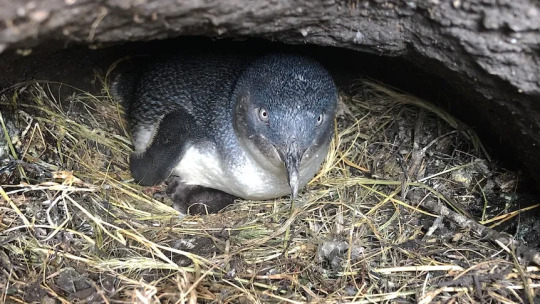
Not far from the centre of Tasmania's fourth largest city, a colony of the world's smallest penguins has been thriving, and their habitat is about to expand into an existing car park.
The bright lights and loud noises of Burnie have not been a deterrent for hundreds of penguins who set up home on the foreshore in the north-west Tasmanian city.
4. Latest population survey yields good news for endangered vaquita porpoise
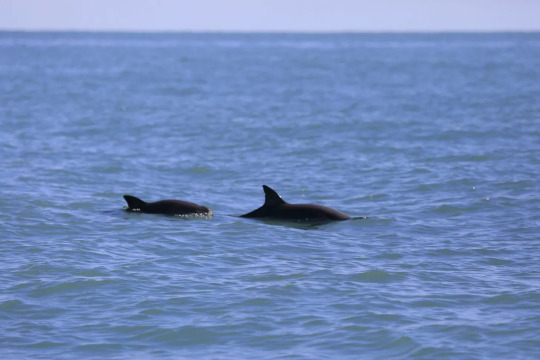
The resilient little vaquita marina appears determined to survive the illegal fishing that has brought it dangerously close to extinction, according to the latest population survey. Despite an estimated annual decline of 45% in 2018, the endangered porpoise appears to be holding steady over the last five years, according to a report published Wednesday by the International Union for Conservation of Nature.
5. 'Extinct' butterfly species reappears in UK
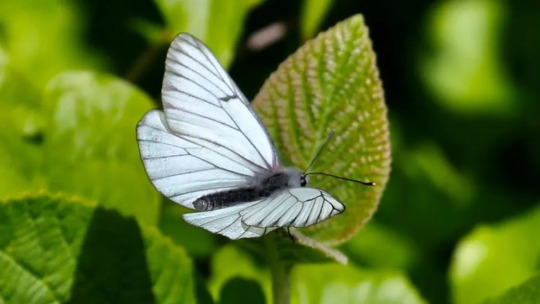
The species, previously described as extinct in Britain for nearly 100 years, has suddenly appeared in countryside on the edge of London. Small numbers of black-veined whites have been spotted flying in fields and hedgerows in south-east London. First listed as a British species during the reign of King Charles II, they officially became extinct in Britain in 1925.
This month they have mysteriously appeared among their favourite habitat: hawthorn and blackthorn trees on the edge of London, where I and other naturalists watched them flitting between hedgerows.
6. Colombian is a hero in Peru: he rescued 25 puppies that were about to die in a fire
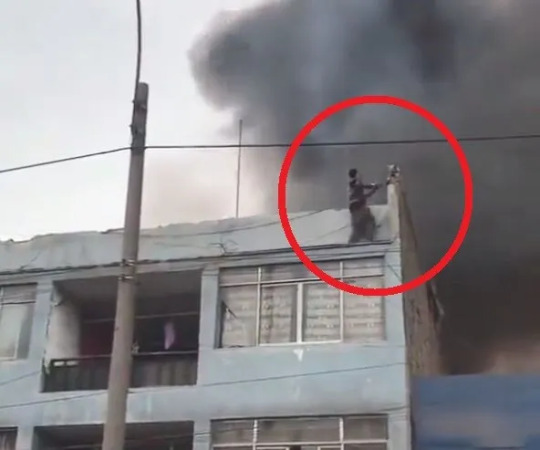
During a structural fire that occurred in a residential area of Lima in Peru, a young Colombian became a hero. The Colombian, identified as Sebastián Arias, climbed onto the roof where the puppies were and threw them towards the community, that was waiting for them with sheets and mattresses. "I love them, dogs fascinate me," said the young man.
7. World-first trial for pediatric brain cancer

Researchers in Australia are conducting a world-first clinical trial for children diagnosed with ependymoma, a rare and devastating brain cancer. The trial aims to test a new drug called Deflexifol, which combines chemotherapy drugs 5-FU and leucovorin, offering potentially less toxic and more effective treatment compared to current options.
Ependymoma is the third most common brain tumor in children, and current treatments often lead to relapses, with a high fatality rate for those affected. The trial, led by researcher David Ziegler at the Kids Cancer Centre, has received support from the Kids with Cancer Foundation and the Cancer Institute NSW. The goal is to find a cure for every child diagnosed with ependymoma.
----
That's it for this week :)
This newsletter will always be free. If you liked this post you can support me with a small kofi donation:
BUY ME A COFFEE ❤️
Also don’t forget to reblog.
SUBCRIBE HERE for more good news in your inbox
606 notes
·
View notes
Text
BOTD: Crested Caracara
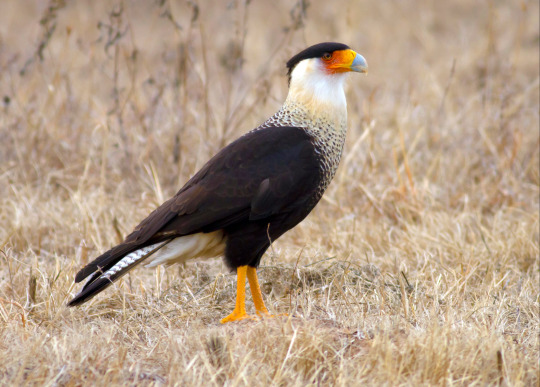
Photo: Manjith Kainickara
"Related to the typical falcons, but very different in shape and habits. The Crested Caracara is a strikingly patterned, broad-winged opportunist that often feeds on carrion. Aggressive, it may chase vultures away from road kills. Widespread in the American tropics, it enters our area only near the Mexican border and in Florida. 'Caracara' comes from a South American Indian name, based on the bird's call."
- Audubon Field Guide
#birds#crested caracara#birds of north america#north american birds#caracaras#falcons#raptors#birds of prey#birds of the us#birds of mexico#birds of central america#birds of caribbean#birding#birdblr#birblr#bird of the day#Caracara cheriway
213 notes
·
View notes
Note
Since it's both World Animals Day and Teachers Day, can you give us animals that is the best and also the best teacher in the world?
1. Best Teacher in the World: Doug
"Teaching" is actually rare in the animal kingdom, but it does happen...
Animal Teachers | Psychology Today
Why animal teachers are so rare—and remarkable (nationalgeographic.com)
2. Animals That Is the Best:
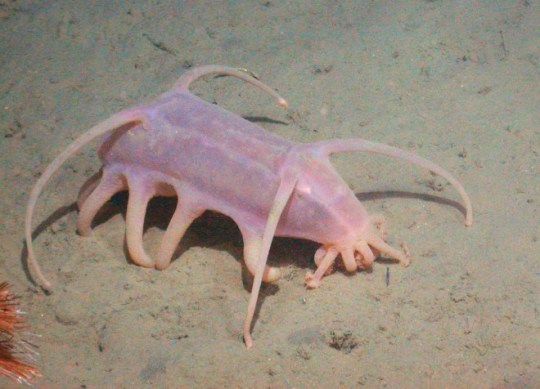
Sea Pig (Scotoplanes globosa), family Elpididae, specimens found in the deep sea off of the Pacific Coast of North America
The Sea Pig is a benthic deep-sea sea cucumber (class Holothuroidea) that walks using long tube-like limbs.
Like most sea cucumbers, they feed on detritus.
They have often been see congregating in groups of up to 30 individuals.
The 3 species of Scotoplanes are difficult to tell apart by sight.
photograph via: MBARI

Vampire Squid (Vampyroteuthis infernalis), family Vampyroteuthidae, photographed in the deep sea off the Pacific Coast of North America
Vampire Squids are not actually true squids, but are in their own distinct groups of Cephalopods (most closely related to the Octopuses).
They only grow to a total length of up to 30 cm (~ 1 ft).
They have many light producing photophores on various locations around their body.
They live at depths of 600 to 900 m (2,000 to 3,000 ft) in oceans around the world.
photograph via: MBARI

Turtle Frog (Myobatrachus gouldii), family Myobtrachidae, Hill River, found in southwestern Australia
photograph by Akash Samuel

Tuatara (Sphenodon punctatus), family Sphenodontidae, New Zealand
There were once 2 recognized species of Tuatara, but now they are considered to be just one species.
This is not a lizard.
The only member of the reptile group Rhynchocephalia still around. All other species went extinct millions of years ago.
Tuataras were eradicated by humans and introduced species from the main islands of New Zealand, and now only occur on small islands near the North Island and far north of the South Island.
This is one of my very favorite animals.
photograph by Sid Mosdell

Mexican Mushroomtongue Salamander (Bolitoglossa mexicana), family Plethodontidae, Sierra Caral, Guatemala
photographs by Laura Bok
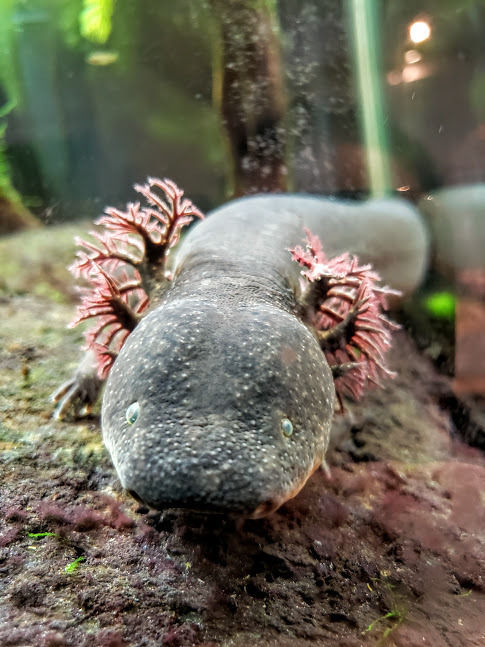

Greater Siren (Siren lacertina), family Sirenidae, found in freshwater habitats in the coastal plains of the SE United States
This large eel-like aquatic salamander retains its gills. They only have 2 tiny front limbs.
They grow to a length of up to 97 cm (38 in).
photographs by Qualiesin
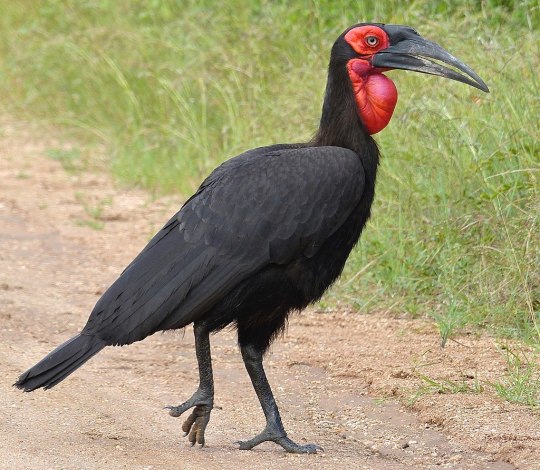
Southern Ground Hornbill (Bucorvus leadbeater), family Bucorvidae, Kruger National Park, South Africa
photograph by Bernard DUPONT

Florida Burrowing Owl (Athene cunicularia floridana), family Strigidae, Cape Coral, Florida, USA
photograph by Cee Z Fotography
173 notes
·
View notes